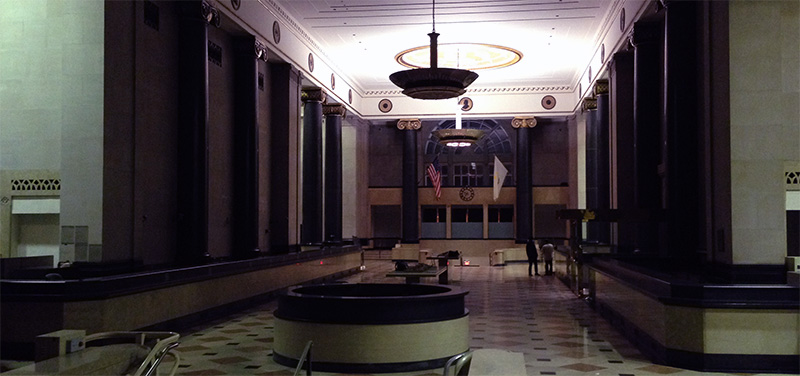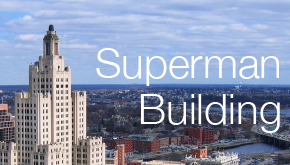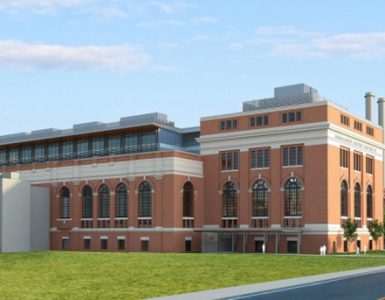
Superman Building banking hall. Image by Jef Nickerson
[alert type=”warning”]Full Disclosure: I work for Cornish Associates who are consultants for High Rock Development.[/alert]The owner of Providence’s tallest building said Monday he will again seek state support to help turn the vacant skyscraper into apartments.
David Sweetser, whose real estate investment firm High Rock Development owns 111 Westminster Street, is calling for a “public-private partnership” to renovate the building that he claims would create hundreds of jobs and generate millions of dollars in tax revenue for the state.




As much as I want to see this redeveloped, it continues to be a mystery to me why we have to put state money into developing luxury condos or apartments if there would be a way to develop more affordable housing through the market. Is there no one who will live in the Superman Building at any price? It’s certainly deteriorated somewhat, but is it really to the point that it’s uninhabitable? The bank was in the bottom floor so recently. . .
I mean, there are lots of externalities created by our transportation and land use system that make it harder to develop in downtowns than it should be, and I recognize there’s a need to counter that. But I’d really like to hear more about why this passes the BS test when it’s primarily seems to benefit an architectural firm and wealthy people who will get to inhabit the new building.
People cannot live in a building with no residential bathrooms, no kitchens, no separated utilities… You cannot just unlock an office building and rent it out to people as a residential building.
As much as some developers and interested parties desperately want us to believe otherwise, there’s actually an extremely broad spectrum of potential housing levels between “subsidized minimally-furnished” and “high-cost, high-end luxury.”
Of course, with it so hard to actually construct residential at all (to say nothing of the tremendous built-up demand) – well, it’s certainly understandable why there’s nobody championing “middle-of-the-road” / moderately-priced housing.
For the record, I think it’s a waste of money that we can’t afford to waste to subsidize even more luxury housing regardless of whether or not the popular school of thought (that a glut of new luxury housing will have a trickle-down impact on existing housing prices… does that rhetoric sound familiar to anyone else??) proves true.
I would like to see a proposal for moderate housing, and I could support a subsidy for the stated goal of developing mid-range apartments. Otherwise, the money that goes into subsidizing redevelopment here is much better spent on infrastructure elsewhere in the city.
I think if it could be micro lofts and apartments ranging from $600 to $1500 a month, with a first floor full grocery store connected to a cvs or Flagship Walgreens, with a pharmacy… it would make me happy
Let’s see, microloffs? Ok well there’s like 300k sqft, let’s pretend they only use 2/3s of it at 225 sqft a microloff– who believes the demand for that kind of housing can fill almost 900 units? Crazy.
As for middle housing– what are you defining as luxury versus middle? With all the work to change the HVAC and run plumbing and electricity properly do we really think middle value rents will cover it? This is not a case where fancy finishes drive the price.
But honestly, James, have you been inside or ever bothered to look at the many pictures that are around from when BOA left? This is no small job for any use but lowest quality office space.
The problem with focusing on high end apartments over affordabilty neglects to take into account that the job market is terrible and does not draw in enough people who can afford the luxury stuff.
If the building could be converted into 1,000 sf 2 bedroom apartments for about 1250 a month, that would be interesting.
Either way, after 38 studios, the state shuld stay away from economic development. Let the private sector gamble on redevelopment.
Jason – no, I don’t think moderately priced housing would cover the cost of the redevelopment.
But to expand the city’s supply of apartments targeted at young families and other 30-somethings; apartments in the 1 to 3 bedroom range (600~750 sf for the one bedrooms, up to 1100~1350 for the three bedrooms; priced around $1.25~$1.75/sf) that aren’t lacking for space or the creature comforts like a full kitchen – but also aren’t geared for “luxury” and loaded out with superfluous furnishings inside and outside the apartment that only drive up the cost and value – that’s absolutely a public need that needs to be met.
Government subsidies are meant for and should be used to meet public needs, so if the target is explicitly mid-range housing and we’ve established that the market value here isn’t enough to make that happen without a subsidy, then there should be a subsidy for that purpose only. Write it in that the rent for the subsidized housing stock is capped at $2/sf for the next ten years, or something like that, to make sure that the mid-range housing doesn’t suddenly “upgrade” into luxury three years from now.
By contrast, since “luxury” housing absolutely can cover its own costs, no subsidy should be provided for luxury housing. Ever.
The most recent Arcade article stated that their waiting list exceeds 2000 people. 2000 people that we are keep from living downcity due to lack of options. I say we.. because who else really cares about the future of the city?
A subsidy from the state (or city) on a real estate project is not the same as a subsidy for a company like 38 Studios.
With real estate there’s a hard asset that’s immobile. With a company there may be some computers, furniture, or “intellectual property,” which are not. The state could insist that it be placed into the first position or creditors, if a default were to take place in exchange for it’s subsidy.
If the building can fit 400 apartments and the state kicked in $50-million that would be about $125,000 per unit.
A mix of apartment types, low, middle, and luxury might be best for the success in the building’s conversion.
My only concern with developing this iconic building into apartments is that:
1) It may not include mixed use. There ought to be a public/retail use at ground level, whether thats a hotel, cafes and restaurants and/or retail kiosks in the main banking hall.
2) That locals will (continue) to be priced out of the rental market.
AND
3) Most units will be devote to the collegiate sect that do little for longterm urban and cultural investment and critical mass. ie. Capital Cove. The Providence G. Regency Plaza. Etc.
The only success that can come from developing this building is through either a single use tenant, government, private industry OR through mixed use. There needs to be more that one reason to go to a building such as this to keep it afloat.
I’d rather the development team look at a bigger vision. I.e. partial hotel & residences with public access cafes and retail kiosks within the main banking hall and a Top of The Hub style restaurant / viewing deck.
Simply focusing on the residential market as a way to ‘save’ this iconic building is not a good longterm, urban investment.
Diversify.
New Marriott. The existing property is dated and not in the ideal location. Maybe a mix of condos and hotel? I agree with some of the sentiment here. We need middle of the road housing in PVD.
I do want to respond to some of your concerns, Andy – I think we agree on some things, but we disagree on others.
The developers are at least talking about reserving 35,000 sf for a ground-floor mixed use purpose, so while we should worry if that changes – it doesn’t appear to be a problem today.
This is why I’m arguing hard for moderate-tier housing, which won’t have this unfortunate pricing out issue.
I don’t think it’d be the end of the world if the housing stock developed here was a combination of rental units and condominiums – perhaps even a fluctuating ratio thereof through rent-to-own and similar concepts – but absolutely, we want to avoid pricing anyone out of the market.
None of those are marketed towards the collegiate sect, unless I’m wildly misinterpreting the marketing for these places. They self-label as luxury at least and going by Regency Plaza’s $/sf I’m inclined to believe them.
But even if this particular redevelopment was marketed towards the collegiate sect, I don’t think that’s a problem. What I do think is a problem are attitudes held by some that all college students are ‘transitional,’ that they’re a problem class, and that we should be trying to drive them all into dorms so that they can get the four year education in a bubble and flee for greener pastures. I’m not accusing you of holding that attitude – but it’s an attitude I’ve gotten from a number of people as a college student and I really do feel like it creates a self-fulfilling prophecy.
Ultimately, if you treat college students like a problem needing a solution you shouldn’t be surprised when they form no connection to the city or the region and summarily leave with degree in hand. If, however, you welcome college students into the city and treat them like you would any other individuals who are prospective new residents of the city (i.e., future “locals”), you might be (but you shouldn’t be) surprised to find that they might actually be more inclined to stick around for a while after graduating.
Not to be overly pedantic, but “single use OR mixed use” covers all possible uses of an active building and for that reason your use of ‘only’ is confusing me a little bit. Are you trying to say that single use is only appropriate here if that single use is a government (or BOA-style private office) tenant? I don’t believe that a single-use building is any different at street level regardless of whether its single use is as government offices or as apartments.
That aside, I’m not sure that the Superman Building is big enough that dividing the space further into ground floor retail / residential / hotel (instead of just ground floor retail / residential) would yield nearly as much of a transformative impact on the Providence housing market, and looking at Google’s new hotel search suggests that there’s actually something of a glut of hotel rooms in Providence driving down the price per night.
I think if we really do need more hotel space, that’s something better served by seeking out the construction of a new hotel building (or three) as a project entirely disconnected from this one.
Jef,
Don’t kitchens and bathrooms typically get built with loans from a bank? Why does the state have to fund those?
I do think that if there are problems with the building that are severe enough that we stand to potentially lose the building, it would make more sense to invest state funds than not to, but putting money into kitchens sounds silly.
Peter,
I think your point about the infrastructure being permanent with a building is a good one, and it does come into the picture, but I don’t think that by itself solves the equity issue.
Jason,
I think your point that micro-lofts couldn’t work in a portion of the building doesn’t make sense. Why not? If you expect x amount of money per square foot in the building, building two apartments out of a footprint that would be one apartment and charging half price for each nets the same result, especially in the case that you’re not adding full-scale kitchen and bathroom stuff to each. And the designers can have whatever flexibility to put whatever different mixes of apartments they want, really, but why should we give them money so that they can put in higher end apartments? Presumably a higher end apartment would amount to things like trucking in the right kind of Indiana limestone to put into the countertops. Why not make formica countertops if that’s what can sell at market price?
And Amen to putting public funding into public things. Why not put state money into improving transit access to the area (it is across from KP), build some protected bike lanes, invest in the schools (people do move to an area on the predication that the schools are decent) and so on.
Kitchen and bathrooms as well as other features of an apartment are often financed by a lender. Unfortunately this building needs much more than what it would typically take to build out living spaces or hotel rooms. The 111 facade is in bad shape and potentially a safety hazard. I heard that repairing it would cost over $10-million. The old HVAC system is designed for a single office user and lacks the capacity for multiple tenants (residential, hotel, retail, or office) and would require replacement even if the building were reused for a single tenant. Asbestos and lead abatement would likely be required. I don’t know the answer to this, but is does the building have a sprinkler system? Even if it has one, it would likely need significant changes and upgrades.
In New York where rents and condo prices minimally are three times that of Downcity, most building conversions and new construction receive heavy subsidies from government. Even if the owner of the property paid too much for the building, what would overshadow that is massive investment required to redevelop the property beyond a conventional conversion. If the state and city don’t offer reasonable subsidies, it’s highly unlikely that anything will happen to the building, but without any help the property could sit empty for long time.
Ryan, isn’t Capitol Cove leased by JWU for student housing? It’s unfortunate, to a point, that it happened, but there are worse situations, like it sitting empty for years.
I don’t have a problem with government subsidies here. It’s an important building in Providence and should absolutely be saved. I’d rather see my tax dollars subsidize that than some private company owned by a multi-millionaire who just doesn’t want to finance his own company.
Runaway Jim: Oops. That’ll teach me not to double check every item in a list.
The Providence G and Regency Plaza are both advertising as luxury. I could’ve sworn Capitol Cove was as well, so I didn’t double check.
Capitol Cove, when originally planned was supposed to be mid-range, no luxury (probably why they can get away with being used as student housing).
Capitol Cove was built to be condos, as was Waterplace. Both were ready to start selling units basically the day the bottom fell out of the economy. Waterplace pivoted to apartments creating a temporary glut in the apartment market as the economy was in free fall. Capitol Cove was smart to lease to JWU as that temporary glut caused by Waterplace would have been hard for them to deal with.
Waterplace has since refinanced and is back to being condos, if memory serves Capitol Cove is near the middle of a 10-(ish?) year lease with JWU, and our apartment occupancies are at around 95% downtown.
I think I definitely support money for things that are imminent problems for the building. For instance, in Philly, when the Divine Lorraine went empty, the roof eventually began to leak, and like many buildings, that caused its deterioration. Although I hope that eventually that building will be restored, letting it just sit and go sour was a bad idea. If the roof is leaking, or if there are broken windows and other really immediate things that are going to impact whether the building gets worse, then I think we definitely should support those, under the rubric that it’s an investment in something that can’t leave the city. And the same probably for the facade, especially because the public as a whole enjoys that, and because of the safety issue. But I think we really ought to look at what the barriers are to getting capital for this for the parts of the project that are really just for the benefit for private residents, and try to fix those. Why can’t we keep the building in a holding pattern, stopping deterioration, and let people fix up parts of it piece by piece, renting bits at a time, and developing capital for future improvements? That’s how houses used to be built in Providence. Rachel’s grandparents built first a floor, and then another floor, and then an addition, etc. We don’t seem to do that type of stuff anymore.
Knock it down